Содержание
- 2. Pneumonia - D efinition Pneumonia is an abnormal inflammatory condition of the lung. It is often
- 3. Community Acquired Pn eu monia Definition: Acute infection of the pulmonary parenchyma that is associated with
- 4. Community-Acquired Pneum onia ( CAP ) ■ Community-acquired ■ pneumonia refers to pneumonia acquired outside of
- 5. Why Community Acquired Pneumonia is a Important disease
- 6. changes in CAP causes major the Functional phy siology of the Respiratory tract
- 7. Who Develops Community Acquire d Pneumonia Community-acquired pneumonia develops in people with limited or no contact
- 8. Risk Factors for pneumonia age alcoholism smoking asthma Immuno suppression institutionalization COPD dementia Community Acquired Pneumonia
- 9. Community acquired pneumonia Emerging Health Problem Causes of CAP - Bacteria, viruses, fungi, and parasites. CAP
- 10. Several Microbes can cause CAP ■ The most commonly identified pathogens are Streptococcus pneumoniae, Haemophilus influenzae,
- 11. Typical x Atypical etiological agents Typical pneumonia usually is caused by bacteria such as Streptococcus pneumoniae.
- 12. X ray chest gives the leading clues in Diagnosis
- 13. Pathophysiology CAP is usually acquired via inhalation or aspiration of pulmonary pathogenic organisms into a lung
- 14. Etiological agents in Community-Acquired Pneumonia in Children From Bi rth to 3 weeks Group B streptococci,
- 15. From 3 weeks to 3 months Streptococcus pneumoniae, viruses (RSV, Parainfluenza viruses, metapneumovirus), Bordetella pertussis, Staphylococcus
- 16. From 4 months to 4 years S. pneumoniae, viruses (RSV, Parainfluenza viruses, influenza viruses, adenovirus, rhinovirus,
- 17. 5 years to 15 years S. pneumoniae, M. pneumoniae, and Chlamydia pneumoniae
- 18. COMMUNITY-ACQUIRED PNEUMONIA IN ADULTS
- 19. Outpatients—with no modifying factors present ■ Streptococcus ■ ■ ■ ■ pneumoniae, Mycoplasma pneumoniae, Chlamydia pneumoniae,
- 20. Outpatients—modifying factors present ■ S. pneumoniae, including drug resistant forms; M. pneumoniae; C. pneumoniae; mixed infection
- 21. CAP in Inpatients not admitted in ICU S. pneumoniae, H. influenzae; C.Pneumonia; C. pneumoniae; mixed infection
- 22. Non-bacterial pathogens causing CAP ■ Non bacterial pathogens in the differential include many viruses (influenza, adenovirus,
- 23. Value of chest x-ray in Diag nosis of CAP A chest x-ray is recommended to make
- 24. Microbiological Diagnosis
- 25. Common Laboratory Tests ■ Common laboratory tests for pneumonia have included leukocyte count, sputum Gram stain,
- 26. Microbiological diagnosis is co nfirmatory ■ Is not possible to distinguish the causative organisms of pneumonia
- 27. Bacteriological Investigations o n sputum Expectorated sputum collected ( poorly collected) without proper instructions may not
- 28. Sputum gram staining and culture A good quality sputum sample with a predominant pus cells with
- 29. Newer methods – Diagnosis of Community associated Pneumonias Antigen detestation in sputum urine by Fluorescent methods
- 30. Diagnosis in cases of Atypical P neumonias By serological methods using acute and convalescent sera Raise
- 31. Other markers suggestive of CAP C - reactive protein trends have been correlated to clinical progress
- 32. Pencillin still continues to be preferr ed antibiotic ■ With a bloodstream or lung infection, you
- 33. Antimicrobial therapy – Empiri ca approach Antimicrobial therapy is the mainstay of management for community-acquired pneumonia
- 34. MRSA – a concern in treating Community acquired Pneumonias The worldwide emergence of community-acquired Methicillin- resistant
- 35. Vaccination in children Vaccination is important in both children and adults. Vaccinations against Haemophilus influenzae and
- 36. Community Acquired Pneumonia and Vaccination for Pneumococcal infect ion ✔ The pneumococcal vaccine (the ‘pneumonia shot’)
- 37. Preventing Inf uenzae According to the U.S. ■ Centers for Disease Control and Prevention (CDC), anyone
- 38. General Health Measures Smoking cessation is important not only for treatment of any underlying lung disease,
- 39. Future goals on reducing child deaths – by Hand washing ■ Handwashing with soap is among
- 41. Скачать презентацию

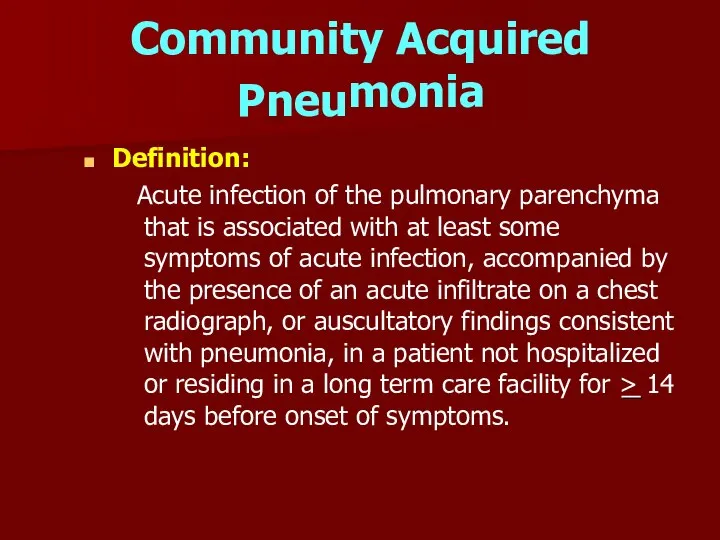
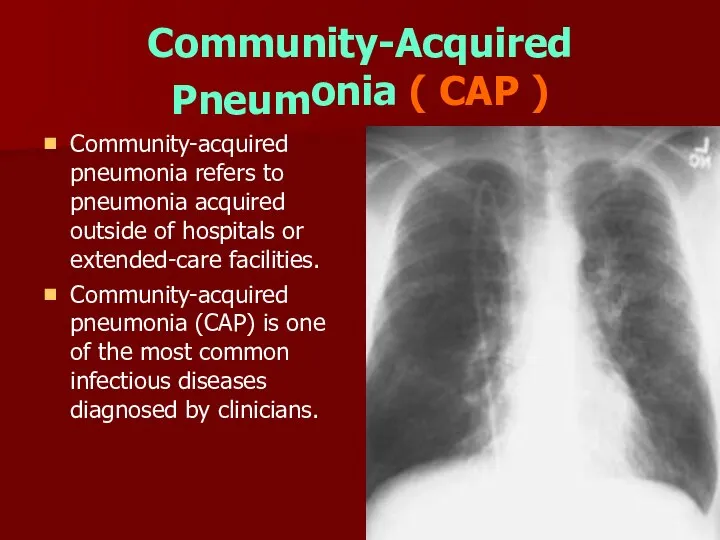

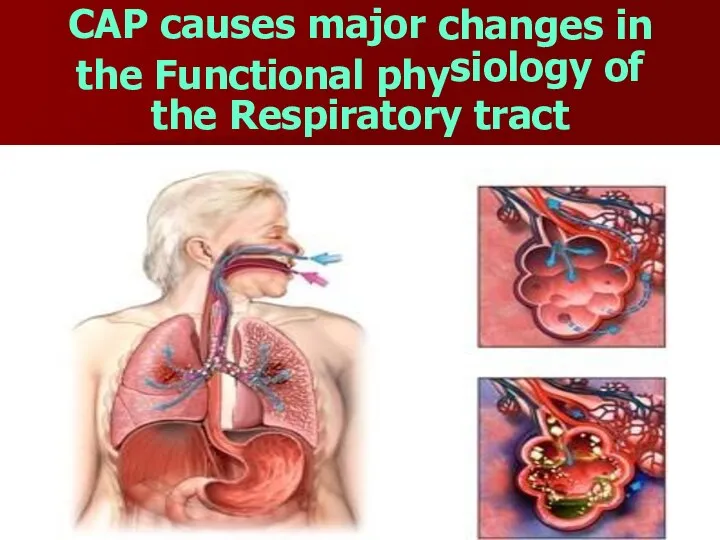
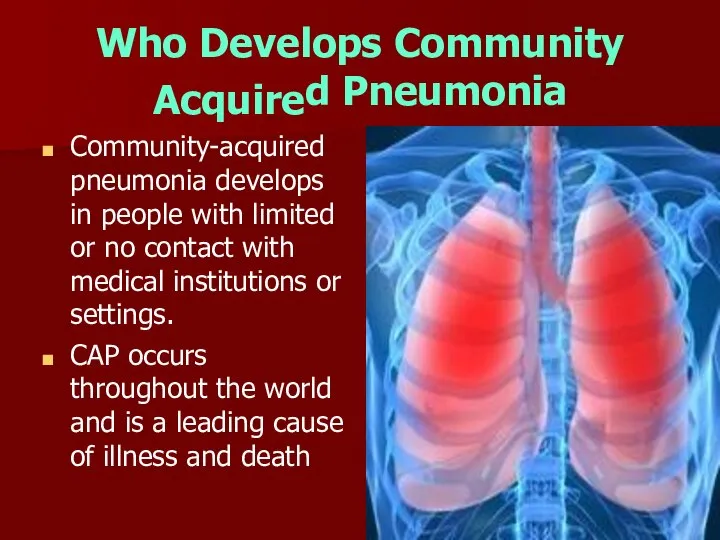
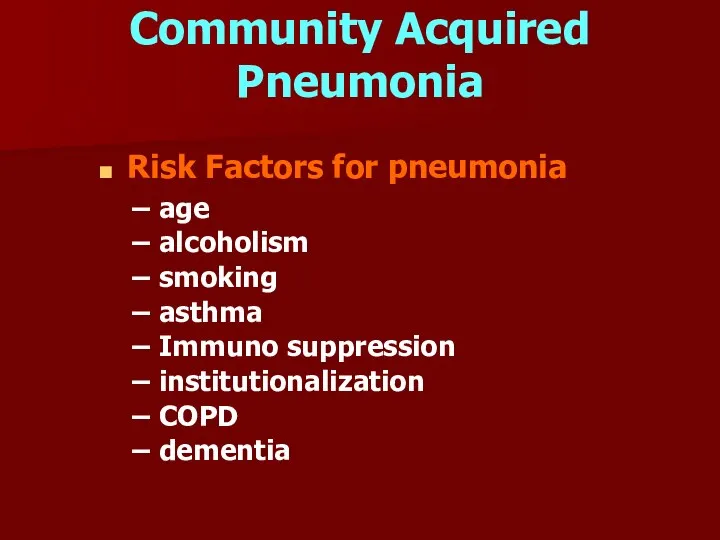
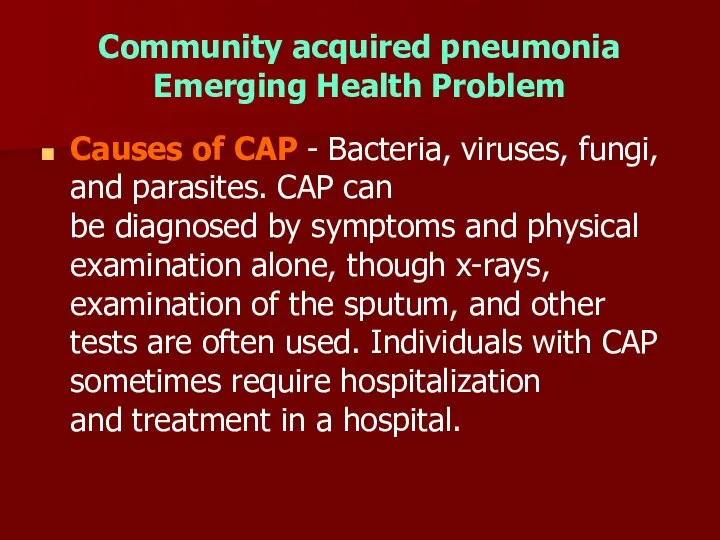

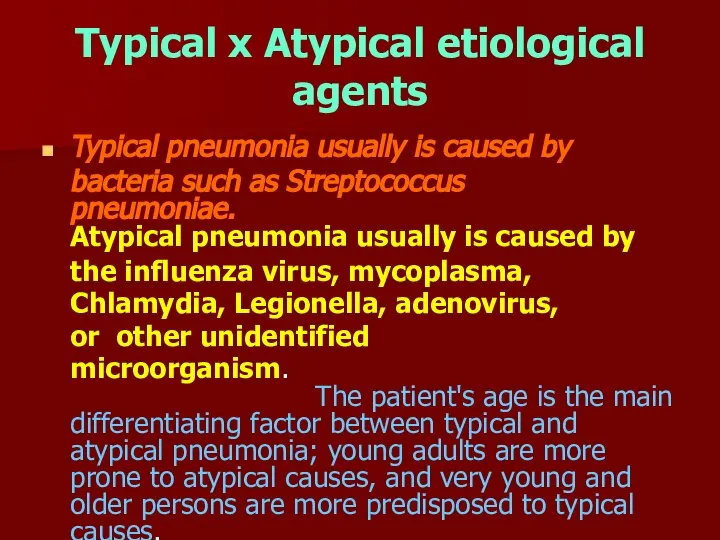
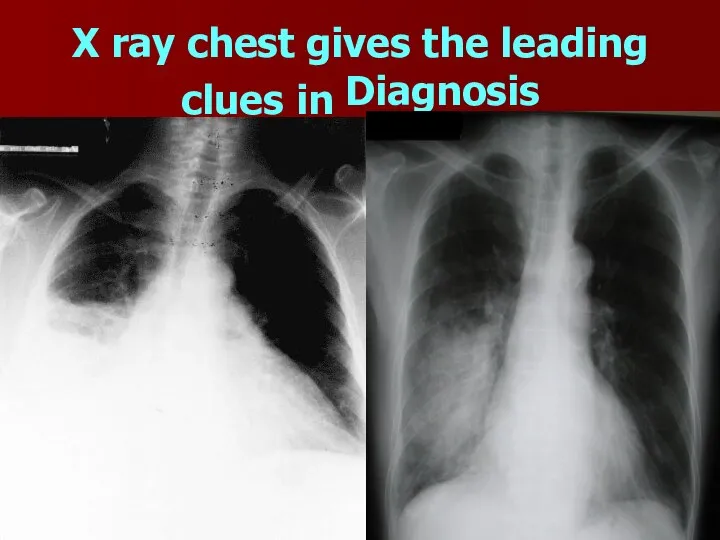
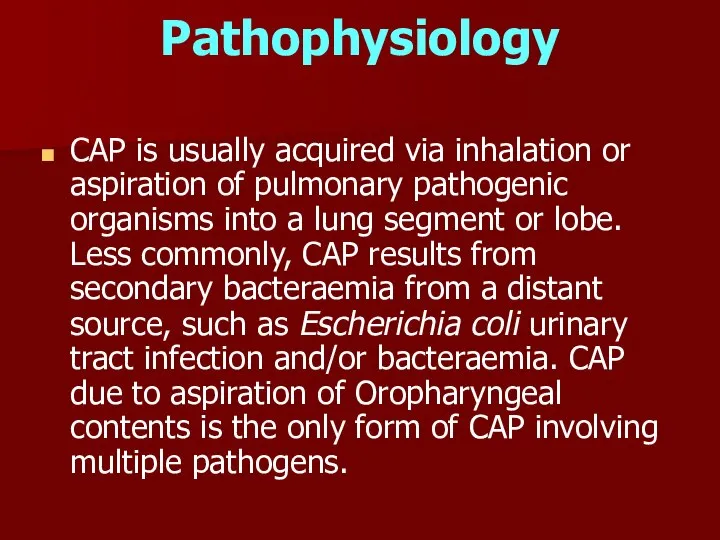
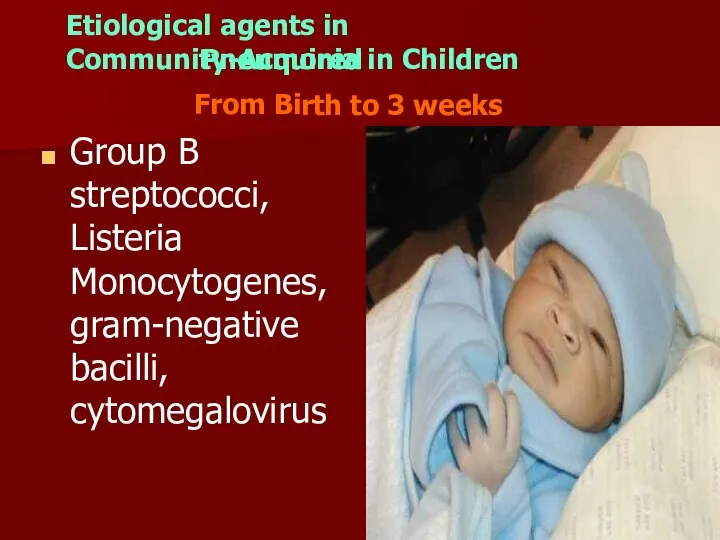

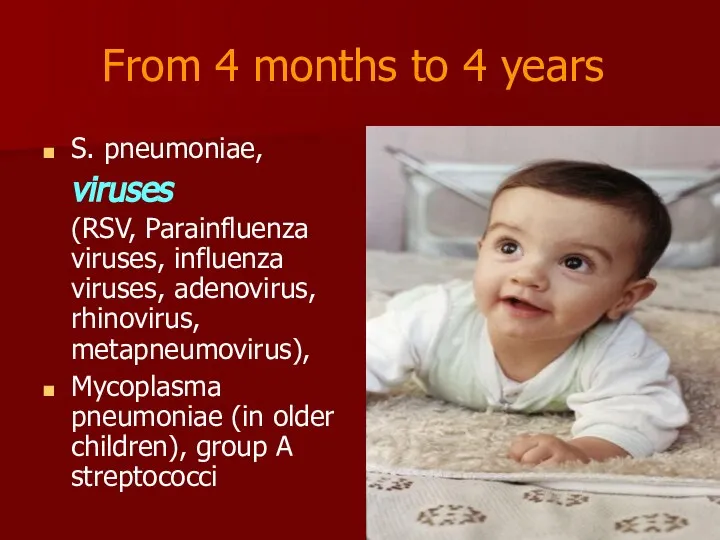
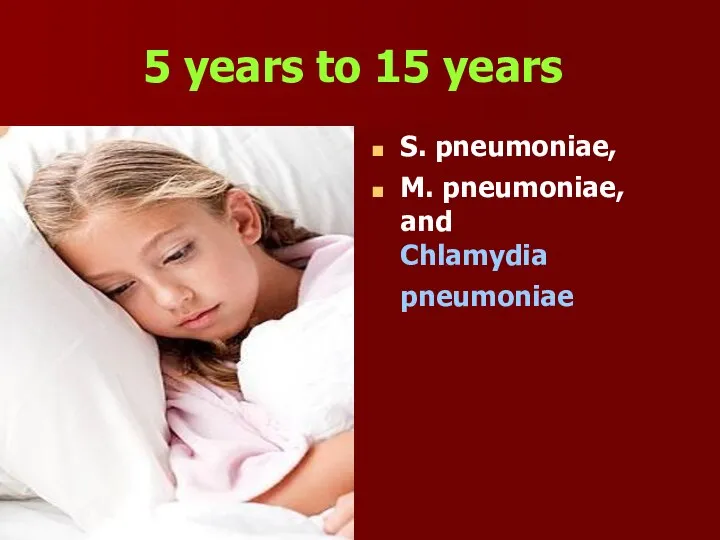
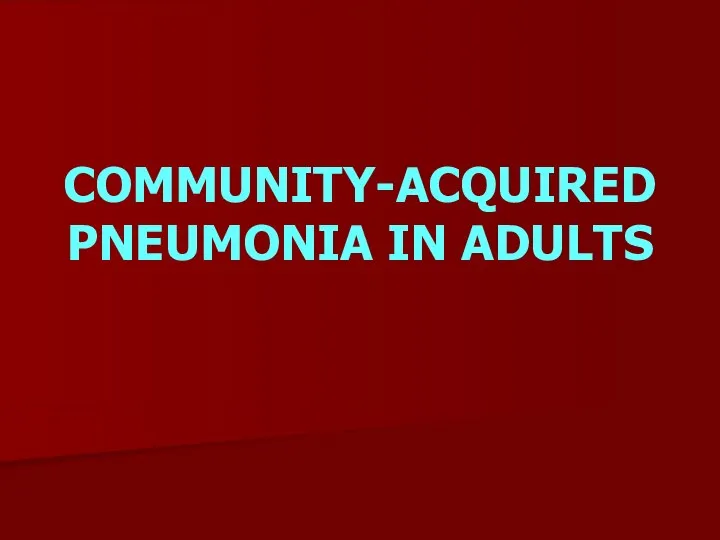
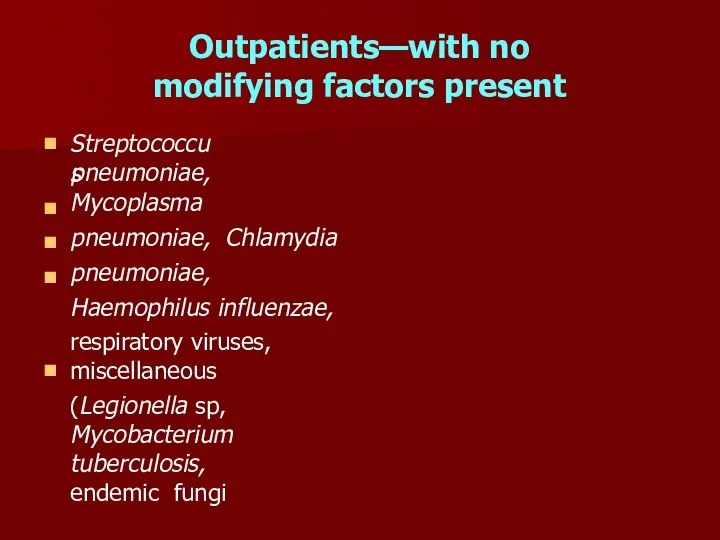
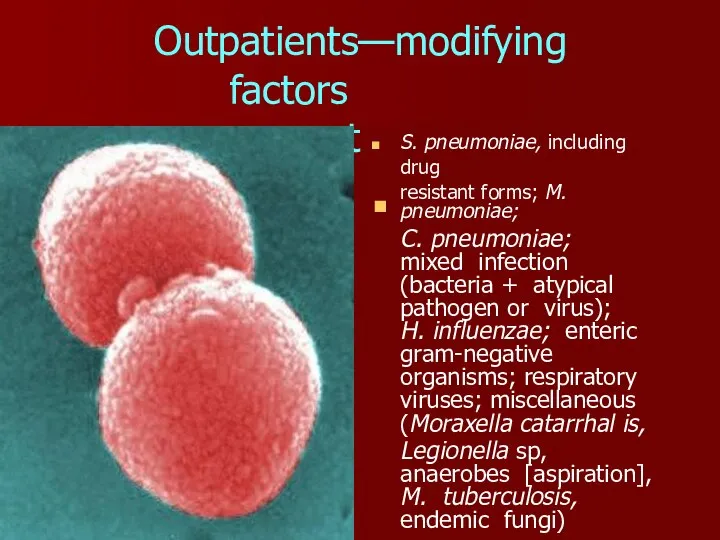
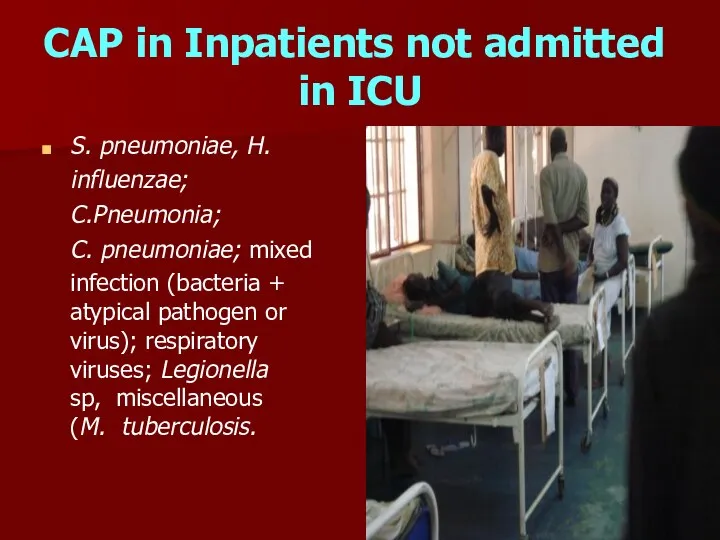
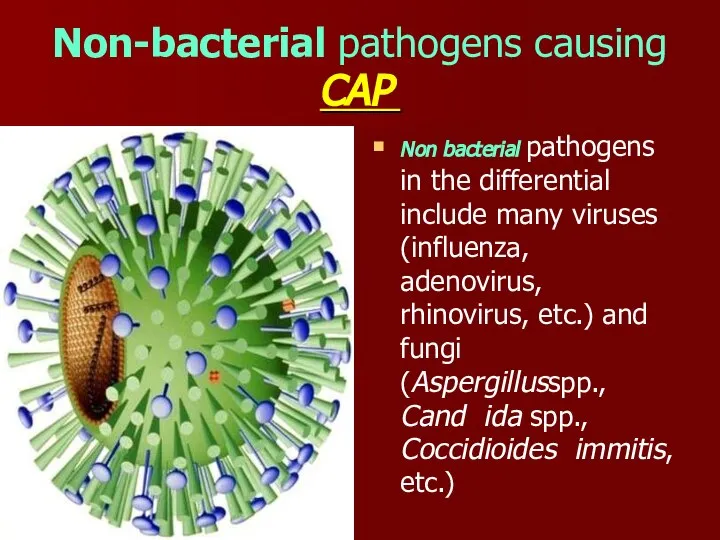
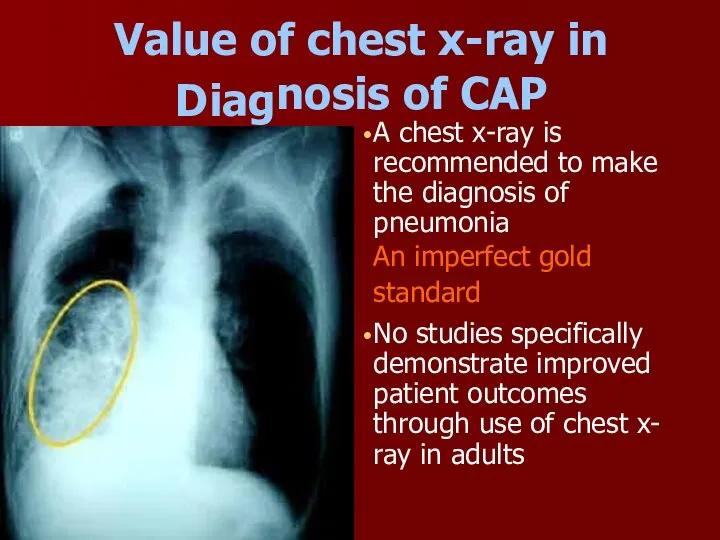
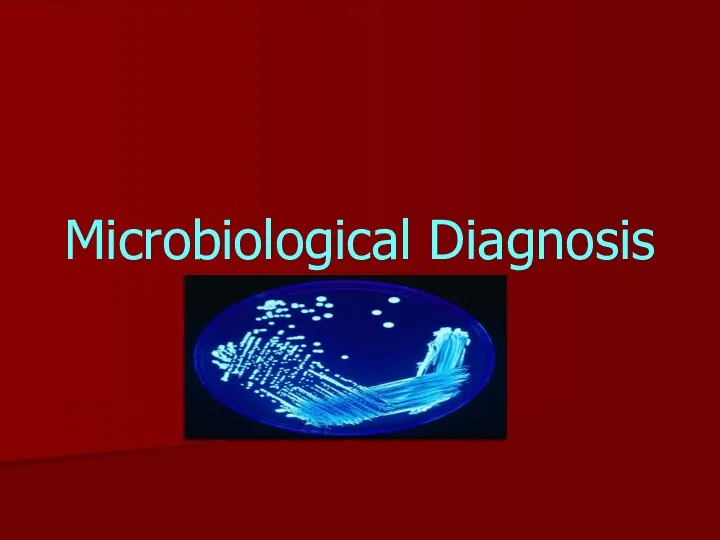


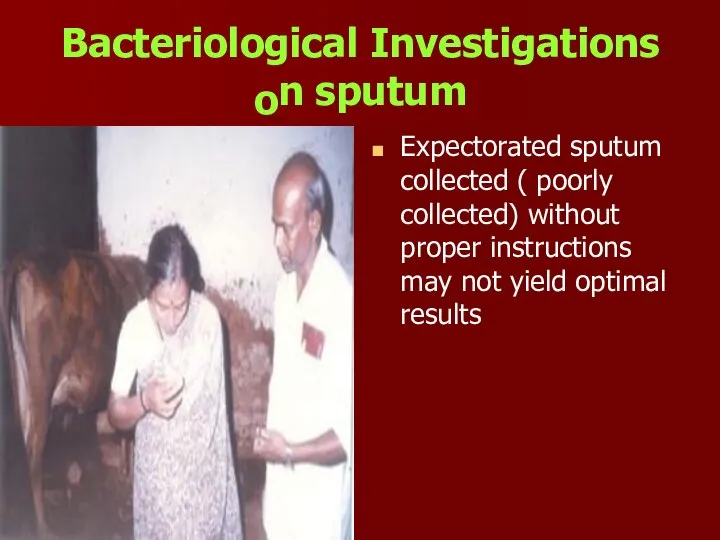
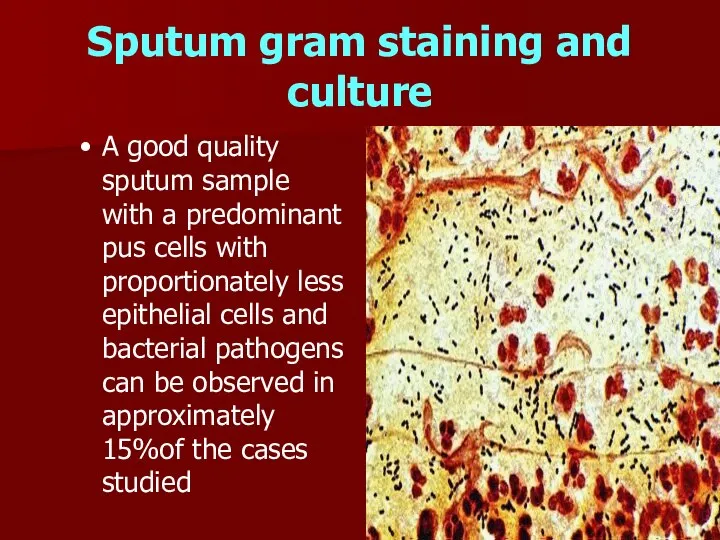


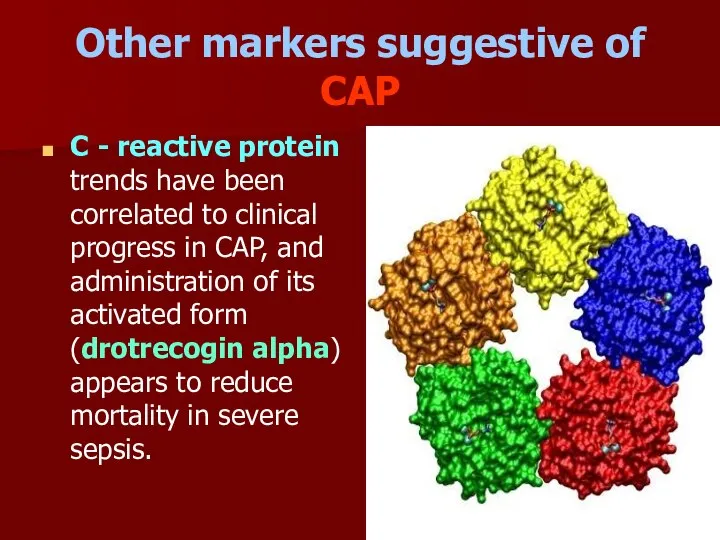
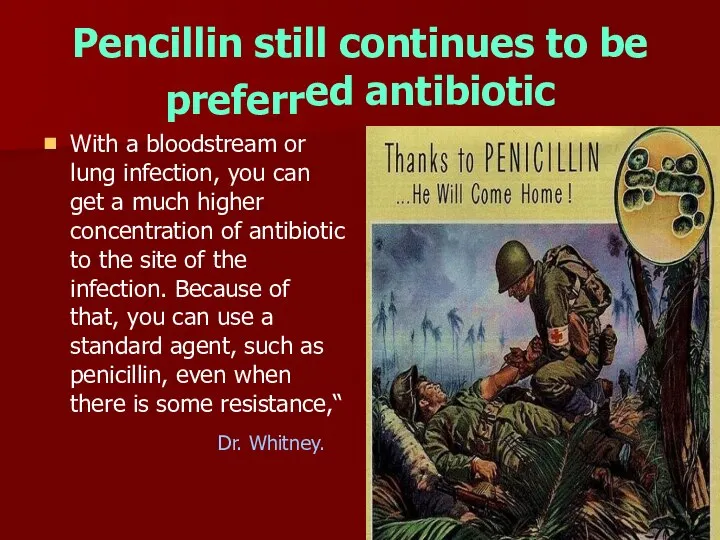

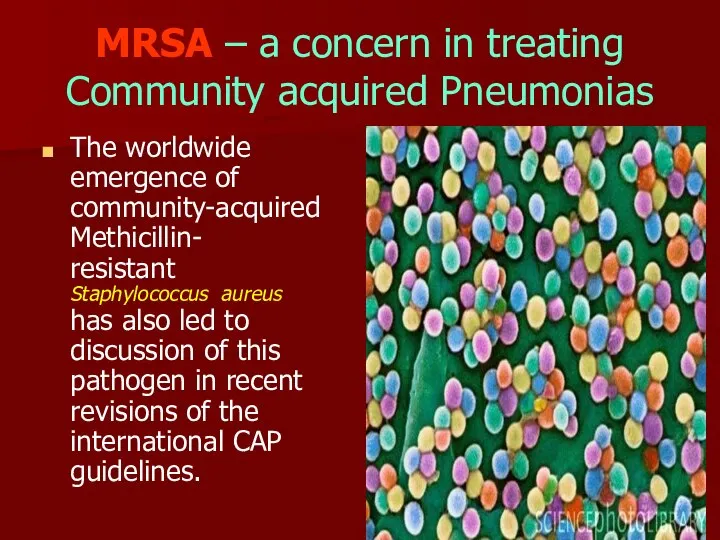
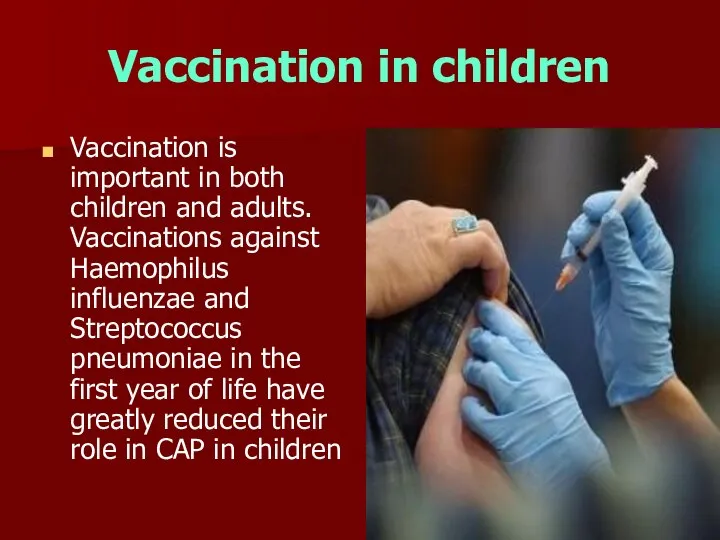
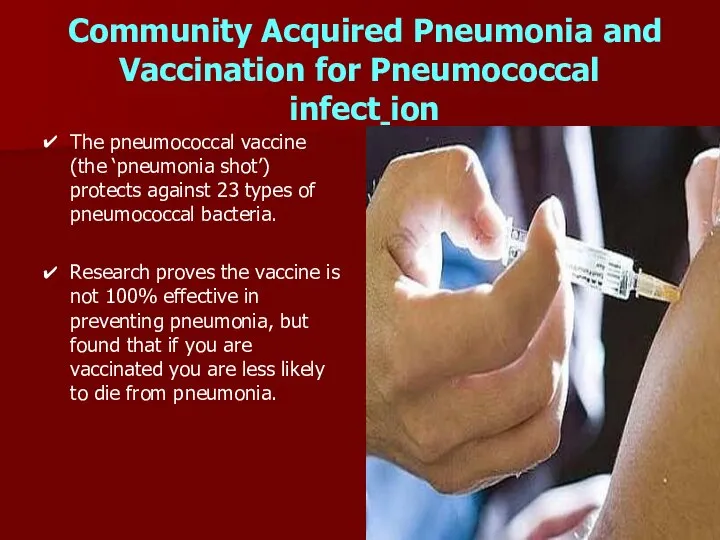

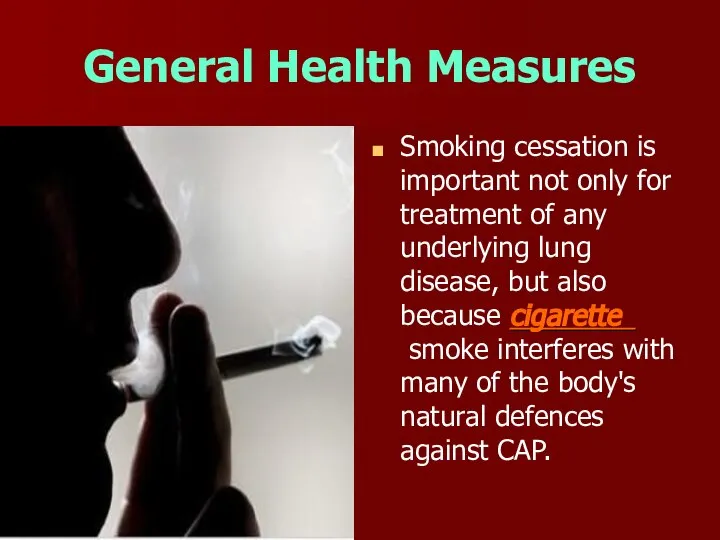
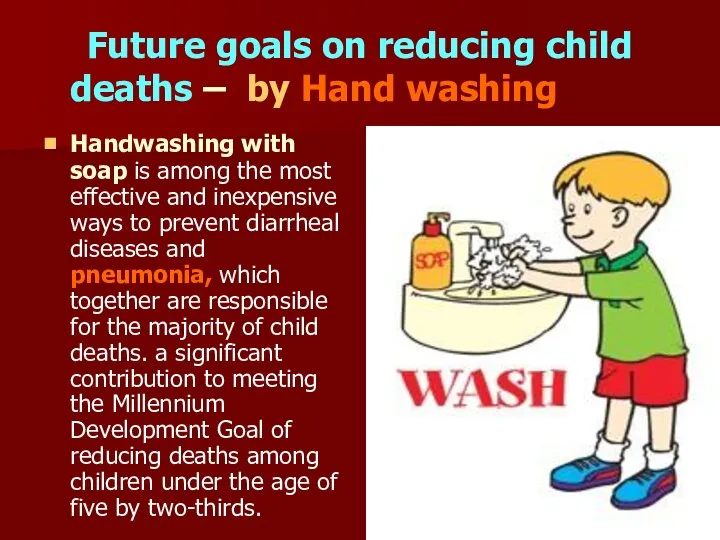
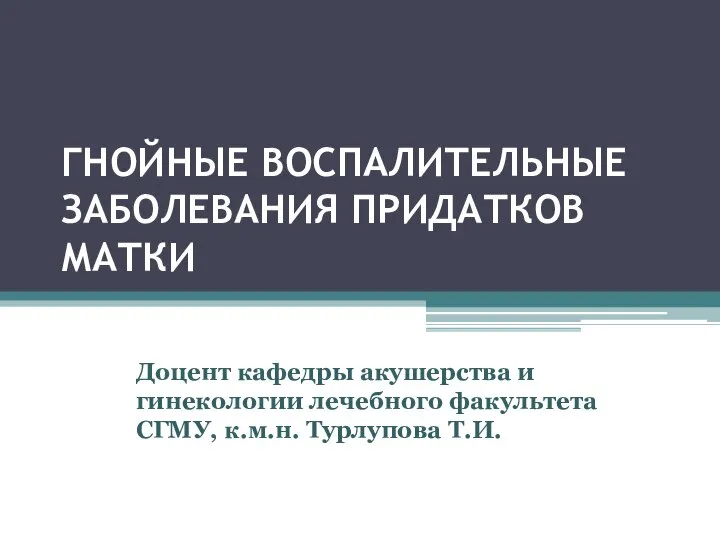 Гнойные воспалительные заболевания придатков матки
Гнойные воспалительные заболевания придатков матки Респираторлы дистресс-синдромының медикаментозды терапиясы
Респираторлы дистресс-синдромының медикаментозды терапиясы Гипотермия. Потеря тепла
Гипотермия. Потеря тепла Способ защиты организма имунитет
Способ защиты организма имунитет Электрокардиограммы
Электрокардиограммы Антитела. Природа, виды, функции антител. Динамика продукции при первичном и вторичном иммунном ответе
Антитела. Природа, виды, функции антител. Динамика продукции при первичном и вторичном иммунном ответе Аптечка. Природные лекарственные средства
Аптечка. Природные лекарственные средства Селен в пищевых и кормовых добавках
Селен в пищевых и кормовых добавках Особенности эхо-кг при гипертрофии, дилатации камер, пороках клапанов
Особенности эхо-кг при гипертрофии, дилатации камер, пороках клапанов Грибная терапия
Грибная терапия Дыхательный тренажёр
Дыхательный тренажёр Гемосидероз
Гемосидероз Auscultația plămânilor ( zgomotele respiratorii principale și supraadăugate)
Auscultația plămânilor ( zgomotele respiratorii principale și supraadăugate) Онлайн-фотовыставка Занятия на года Наш выбор – здоровье!
Онлайн-фотовыставка Занятия на года Наш выбор – здоровье! О реализации в Удмуртской Республике комплекса мер, направленных на формирование здорового образа жизни среди населения
О реализации в Удмуртской Республике комплекса мер, направленных на формирование здорового образа жизни среди населения Эпиднадзор за дифтерией в условиях спорадической заболеваемости в России
Эпиднадзор за дифтерией в условиях спорадической заболеваемости в России Острые кишечные инфекции
Острые кишечные инфекции Жировоск, или откуда на земле появились мыльные люди
Жировоск, или откуда на земле появились мыльные люди КОВИД-вакцинация
КОВИД-вакцинация Анестезиологическое обеспечение ортотопической трансплантации печени
Анестезиологическое обеспечение ортотопической трансплантации печени Правила личной гигиены
Правила личной гигиены Экстремальные состояния
Экстремальные состояния Магнитно-резонансная томография
Магнитно-резонансная томография Беременная с желудочковой аритмией - еще одна проблема кардиолога
Беременная с желудочковой аритмией - еще одна проблема кардиолога Что такое ЗОЖ
Что такое ЗОЖ Группа риска. Роль санитарнопросветительной работы в снижении заболеваемости ИППП
Группа риска. Роль санитарнопросветительной работы в снижении заболеваемости ИППП Редкие виды расстройств пищевого поведения
Редкие виды расстройств пищевого поведения Рефлекторный принцип нервной регуляции. Поведение. Высшая нервная деятельность
Рефлекторный принцип нервной регуляции. Поведение. Высшая нервная деятельность